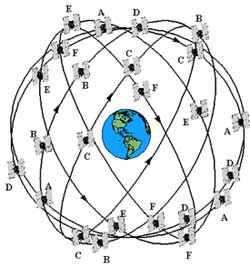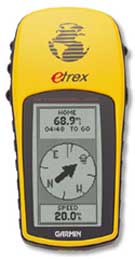Build It and They Will Come: The Far-Reaching Effects of Global Positioning Systems
This article was initially published in Today's Engineer on January 2005
For more than a millennium after the fall of Rome, Western Europe’s existence was one of great geopolitical uncertainty. Great land empires to the south and east constantly threatened to overrun Europe. Unable to advance its commercial, political and military ambitions by land, Europe’s Atlantic nation-states turned to the world’s oceans.
By the end of the 15th century, the Portuguese, Spanish, Dutch and English were locked in a ferocious battle for global maritime supremacy, in both trade and war. Superior scientific and technological know-how in navigation and cartography were great advantages in this competitive struggle. The success or failure of maritime ventures depended on determining location on the earth’s surface. Where am I in this vast ocean? Where are the Spice Islands and other sources of wealth? Where are the treacherous reefs and rocks? Where are my enemies’ ships? Good answers led to personal glory and great fortunes, while wrong answers often led to human tragedy or financial ruin.
The intellectual awakenings of the Renaissance, with its strong empiricist view of knowledge, the irresistible seductiveness of fortunes to be made from exotic products, and the mythical aura of distant lands, created an unquenchable thirst for geographic knowledge. Forgotten for nearly 1,200 years, Ptolemy’s methods and ideas of mapping the globe were rediscovered. Astronomy and mathematics enabled people to use the celestial bodies as the eternal reference from which to calculate the latitude and longitude of any place on Earth. Triangulation, for example, enabled us to survey the planet and produce more accurately scaled maps. For the first time, perspectives of the Earth were being drawn. Globes of the earth started to appear. Mercator’s projection was an invaluable boon to mariners. The need for navigation and cartography led to more precise measuring instruments. The search for a practical way to measure longitude at sea helped drive improvements in clock technology. The paradigms and methods of navigation and mapmaking then remained pretty much the same until the mid-20th century, when a dramatic change took place.
The Birth of NAVSTAR
In 1964, the U.S. Navy deployed the satellite system Transit, the forerunner of today’s global positioning system (GPS). By means of Doppler shift techniques, Transit used seven low-altitude polar-orbiting satellites to determine positions of Navy ships and ballistic submarines across the world’s oceans.
During the same year, the Navy started work on a second, more sophisticated system called Timation. From the Air Force’s perspective, the Navy’s satellite navigation system had critical limitations: location was specified in only two dimensions, its coverage was not continuous and its response time was too slow for fast-moving jets. The Air Force set out to design its own system.
Prompted by cost and the need for inter-service operability, the Department of Defense (DOD) called for a coordinated approach. In 1968, DOD established a tri-service steering committee called the Navigation Satellite Executive Group (NAVSEG). NAVSEG spent several years hammering out a set of specifications — the number of satellites, type of orbit, signal protocols and modulation techniques — and developing cost estimates that all of the services could accept. By 1973, the group reached a compromise, and in 1974, DOD started the long-term project to build the NAVSTAR GPS.
Another 20 years would pass before the GPS would reach its current configuration. In 1994, the 24th and final satellite in the GPS was in orbit. By 1995, DOD stated that it had spent about $8 billion to develop and deploy GPS. To this day, DOD still owns and operates the world’s global positioning system. GPS’ 24 satellites lie in six orbital planes and circle 20,200 km above the Earth in 12-hour orbits. GPS technology was successfully used in the U.S-Iraq War (1990-1991) and U.S interventions in Kosovo (1999) and Afghanistan (2001-2002).
GPS can locate position in three dimensions to within a few feet anywhere on the globe. Following the principle of satellite navigation, position is determined through measurement of distance from each of three objects whose positions (i.e., coordinates in a well-defined reference frame) are known. A fourth estimate measures time, thus compensating for receiver clock bias, the temporal inaccuracy that affects all satellites equally with use of inexpensive quartz oscillators in GPS receivers. And while users need four satellites to fix a position, the system has added redundancy; users can always access at least five satellites from any point on the Earth’s surface. In order to implement a global navigation system based on this principle, GPS has fielded a constellation of 24 satellites in medium-earth orbits with a 12-hour orbital period. These satellites are the objects at known locations from which a GPS receiver measures ranges. The distance between the user and a satellite is measured in terms of the time it takes a radio signal to travel from the satellite to the user. GPS’ level of accuracy, immediacy of response and geographic scale are historically unprecedented.
Build It and They Will Come
These dramatic quantitative improvements in precision, speed and scale opened the door to profound qualitative change in society. DOD had originally designed and built the GPS system to serve military needs exclusively. But even before NAVSTAR GPS was fully operational, the civilian market — predominantly the maritime and aviation industries — was knocking on DOD’s door, asking for access to the system. Few could have imagined the diverse applications GPS could accommodate and the mass-market appeal it could generate.The mass appeal of GPS is an unintended consequence of the military’s willingness to risk great sums of money for the cause of precision. Where am I? Where is it? Where are they? For the Pentagon, answers to these geographic questions were essential to the effectiveness of the command and control of America’s worldwide military resources. An approximate answer was not good enough. Location had to be given at the technical limits of precision, available at any instant in time and for any position on the planet. It is hard to imagine any profit-driven institution, committing to spend billions of dollars to answer these questions. How could one ever get any reasonable return on such a massive investment? Where was the market to justify the great financial risks? But supply created a demand. GPS is an excellent example of the movie cliché “build it and they will come.”
DOD never had any intention of inviting civilians to its “field of dreams.” But after the Soviet downing of Korean Air flight 007 in 1983, President Reagan agreed to make GPS available to the civil aviation industry. In 1991, the United States made GPS available on a continuous basis for civilian use around the world, without charging any direct fees. To protect its strategic interests, DOD incorporated a “selective availability” (SA) technique in 1990. SA was the purposeful, random worldwide degradation of GPS’s accuracy in the data available to civilians. But on 1 May 2000, President Clinton signed an order that the intentional degradation of the civilian GPS be discontinued. Overnight, the accuracy of GPS offered to civilians increased by a factor of 10 and the door to the mass market opened wide.
Far-Reaching Impact
GPS's impact on economic activities such as civil aviation, commercial maritime transportation, agriculture, surveying, mineral exploration and environmental management has been considerable. In addition to accurate positioning data, GPS also offers easy and universal access to highly accurate timing signals. Rather than maintaining private and expensive atomic clocks, users can exploit signals from GPS to synchronize electric power grids to data communications networks.
GPS use has also found its way to recreation. The real-time availability of high geographic precision has considerably improved boating safety, has helped fishermen find their favorite spots on the water, and has given hunters and hikers a new spatial awareness of the wilderness. Golfers can now know the remaining distance they need to reach the green. But perhaps the greatest impact GPS has and will continue to have on society has come from embedding precise spatial awareness in consumer items such as cell phones and automobiles.
When used from a conventional land-line telephone, 911 emergency services can automatically pinpoint the origin of the call and ensure a quick response. But a cell phone is not fixed to a particular address. If cell phone users call 911, they often find it difficult to specify their location. In 2001, the Federal Communications Committee mandated that cell phones be equipped with technology that would allow the 911 system to locate the caller. With SA removed, GPS offers the solution. Beyond emergency services, GPS-equipped cell phones have far greater effect on personal lives. For example, cell phone users can get directions to their favorite restaurants or other destinations quickly. Along similar lines, GPS offers motorists real-time, speech-based driving instructions. As GPS receiver prices drop, every car may soon be equipped with sophisticated navigational electronics that will be able to match up the driver’s position with a vast geographical database of people, places and services.
Through applications in land transportation, civil aviation, maritime commerce, surveying and mapping, construction, mining, agriculture, earth science, electric power systems, telecommunications, and outdoor recreational activities, GPS is well on its way to becoming an essential part of the commercial and public infrastructure. With GPS, you can determine your three-dimensional position instantaneously, continuously, and globally with an accuracy of several meters. Thanks to precise and ultra-stable clocks carried aboard the satellites, an inexpensive GPS receiver can also serve as a precise clock, keeping time with an accuracy of about 0.1 microsecond (a tenth of one millionth of a second). In fact, GPS has become a true global time reference for commercial and scientific activities. GPS users the world over have become accustomed to such accuracy in specifying position and time. The only requirement is for the receiver antenna to have a halfway clear view of the sky to be able to “see” a minimum of four satellites.
Privacy Issues Likely to Arise
With the technological capability of knowing everyone’s position in real time, important privacy issues will surely arise. There will certainly be abuses. Real-time geographic precision, for example, will raise telemarketing to a new level of annoyance. Imagine having your cell phone flooded with spam text messages and phone calls every time you pass within a certain distance of a store eager to promote its products. Beyond being an aggravating nuisance, there are also questions of personal freedom. What legal protection would citizens have from over-zealous law enforcement agencies using cell phones to track people's movement?
For most of history, the sun, moon and star-filled heavens offered humanity an eternal reference frame. By the end of the 20th century, satellites had displaced the celestial sphere. GPS is far less romantic and mythic, but its societal impact may prove to be far greater.
- Communication systems
- Telecommunications
- Satellite communication
- Engineering and society
- International affairs & development
- Leisure
- Military applications
- Cold War
- Transportation planning
- Health and safety
- Aerospace safety
- Disasters & accidents
- Safety devices
- Transportation
- Command and control systems
- Military aerospace equipment
- Satellites
- Air transportation
- Aviation
- Navigation
- Satellite navigation systems
- Aircraft
- Marine vehicles
- Remotely operated vehicles
- Road vehicles

